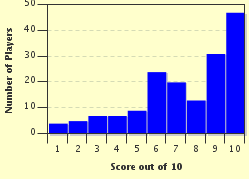Quiz Answer Key and Fun Facts
1. The first subject of the investigation wrote his memoirs ten years after the Civil War ended. His men affectionately called him 'Uncle Billy' and he was named after a famous Shawnee war chief. He is reviled even to this day in the South for the way he conducted the war. In which memoirs would you find his story?
2. Which Confederate general wrote "From Manassas to Appomattox", was nicknamed Lee's 'Old War Horse', became detested in the South after the war for his association with President Grant, and is the next focus of the inquiry?
3. This next autobiography belongs to a general who wrote it 20 years after the war he had been involved in. After that war he had become president but, interestingly, his memoirs focused mainly on his war years. His friends at West point called him Sam and he became known as 'Unconditional Surrender' because of his terms offered during the war. Which general's book fits this description and is the next target of our case?
4. The next general in our spotlight wrote "My Experiences in the World War", his memoirs of his experiences at war. He won a Pulitzer prize for history for the book. He earned his nickname as an instructor at West Point, a nickname that is the same as the gambling game 'Twenty-one' (although different in spelling as his is two words and the game is one). Which general now falls under the scrutiny of this inquisition?
5. This next general wrote two different memoirs - "A Soldier's Story" and "A General's Life: An Autobiography". During WWII, Ernie Pyle nicknamed him the 'GI's General', a name that stuck with him for the rest of his life. Who is our next person of interest in this ongoing investigation?
6. The next possible witness to be interviewed was the most decorated soldier of World War II. His autobiography was entitled "To Hell and Back" and was made into a movie with him in the starring role. Who was this soldier turned actor?
7. "War As I Knew It" was written by one of the most flamboyant figures to emerge from World War II. Who was this commander who was probably the most feared Allied commander from the German perspective because of the daring tactics he employed while driving the Third Army across Europe?
8. The next person of interest in the investigation is this Iran-Contra figure who served in Vietnam, worked for the National Security Council under President Reagan, testified before Congress during the scandal, wrote the autobiography "Under Fire: An American Story", and has since become a best-selling "New York Times" author. Which former Marine is under the microscope now?
9. Richard Marcinko, the next subject of our inquiry, is a former Navy SEAL who was the first commander of the legendary SEAL Team Six and founder of Red Cell. Being that Marcinko spent his life in covert operations, his autobiography could be covertly titled "Renegade Samurai". What is the title of Marcinko's autobiography?
10. The final focus of investigation is General 'Stormin' Norman' Schwarzkopf who commanded Allied forces during the Persian Gulf War in 1991 and in so doing became a national hero. His autobiography was published in 1992 and was titled "It Doesn't Take ___: The Autobiography of General H. Norman Schwarzkopf". What word or words fills in the blank?
Source: Author
tazman6619
This quiz was reviewed by FunTrivia editor
looney_tunes before going online.
Any errors found in FunTrivia content are routinely corrected through our feedback system.

